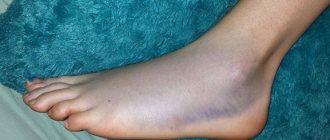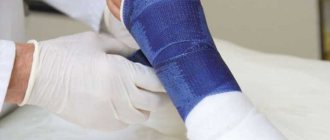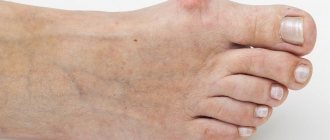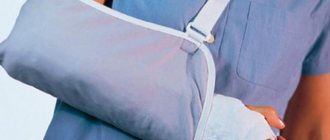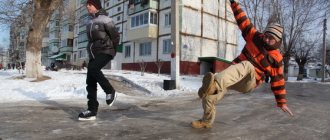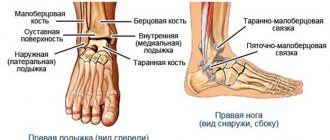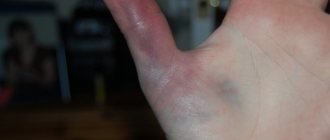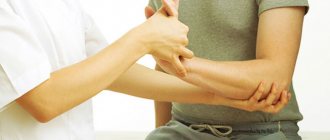Last Updated on 06/14/2018 by Perelomanet
A hand bruise is a closed tissue injury, most often caused by a fall or blow. It can be accompanied not only by damage to muscles, subcutaneous tissue and skin with the formation of a bruise, but also by injury to joints or bone elements - the elbow, phalanges, shoulder. In case of a bruise, the skin remains intact - and this is the main difference between this type of injury and other injuries. The method of treating a bruised limb is chosen by the doctor depending on the degree of injury and its symptoms. In this article, you will learn exactly what to do if you have a bruise of the upper extremities, the correct first aid for bruises, and what treatment methods to use for subsequent relief of the condition.
You can get a bruise during excessive physical activity, accidentally or from a fall. Such damage often occurs in everyday life, during sports activities and in winter during icy conditions. IN
The risk group includes very active children and adults engaged in physical activity. If you do not follow safety precautions, the likelihood of getting a bruise to your hand, elbow or shoulder increases significantly.
Symptoms of a hand injury
When a hand is bruised, the victim experiences pain and sees swelling of the limb; after some time, a bluish-red bruise appears at the site of the injury, which gradually turns yellowish-green. This bruise appears due to the fact that the vessels are damaged, and the blood flows out of them and accumulates along with the intercellular fluid in the soft tissues.
If the victim is unable to raise his arm up after a bruise, it means that the tendons of the rotator cuff have ruptured. In such a situation, you should immediately contact a traumatologist. The larger the size of the hematoma and the richer its color, the larger the vessels that were damaged during the injury, and the more time it will take to heal this damage.
The main symptoms of a blow to the elbow joint are bruising and severe swelling.
Since large nerve endings are located in this place, and a certain stiffness of movements is observed, pain in this case will be more pronounced. If, with such an injury, the pain and limited movement in the elbow do not decrease after 2-3 days, it means that the periosteum has been damaged or fluid has accumulated in the joint.
A bruise to the hand or wrist may be accompanied by nerve damage, and loss of sensation may be felt in these parts of the hand.
If deformation of the fingers is visually visible, there are disturbances in their activity, and the swelling does not subside over time, this may be a sign of a fracture.
Consequences
Mild bruises with adequate treatment disappear without consequences within 10-12 days. However, untimely first aid or incorrect assessment of the severity of the injury can lead to:
- Suppuration of subcutaneous bruising;
- Impaired blood flow in the limb;
- The appearance of painful compaction in soft tissues;
- Impaired motor activity of the injured hand;
- Trauma to the nerve roots leading to numbness.
It will take several months to treat complications after a bruise. In particularly severe cases, surgery may be necessary. Do not ignore household injuries accompanied by severe pain, swelling and bruises.
First aid for a bruised hand
Every person should know what to do first if they have a hand injury:
- An ice pack or any cold object is applied to the damaged area for 20-40 minutes. This will help calm and reduce swelling. A cold compress must be applied through a cloth;
- open wounds and scratches, without which a fall or blow simply cannot be avoided, must be treated with an antiseptic (brilliant, hydrogen peroxide, medical alcohol, Cefazolin powder);
- the limb is provided with complete rest, it is fixed in a motionless state with an elastic bandage;
- a severe bruise of the hand can cause severe pain, to relieve which painkillers are used (Analgin, Solpadeine, Pentalgin, Ibuprofen);
- if your hand is swollen after a bruise, local gels and ointments for bruises, which have an anti-inflammatory effect (Diclofenac, Gevkamen), will help relieve swelling and at the same time relieve pain.
Angioprotectors
Treatment of a bruise of the hand caused by a blow or a fall is carried out to minimize possible complications. They are often provoked by extensive hematomas that arise due to damage to small blood vessels and the release of biological fluids into the subcutaneous tissue. To prevent the development of events in such a negative scenario, immediately after diagnosing a bruise, traumatologists prescribe ointments and gels with angioprotective effects to patients. A course of external agents prevents an increase in the distensibility of blood vessels, the occurrence of venous stagnation, and helps improve lymphatic drainage and microcirculation by increasing capillary resistance. Rapid resorption of hematomas is also ensured by the following clinical effects of angioprotective ointments:
- decrease in capillary permeability;
- decreased adhesion of leukocytes to vascular walls;
- acceleration of tissue regeneration due to the supply of sufficient amounts of molecular oxygen;
- relief of inflammatory processes by enhancing the vasoconstrictor effect of adrenaline;
- blocking the production of free radicals.
The gel Troxerutin and its imported analogue Troxevasin have proven themselves well in the treatment of hematomas. External preparations have a high degree of bioavailability, but no absorption into the bloodstream occurs. After applying the gel-like product, it is quickly absorbed and evenly distributed in the subcutaneous tissue. Contraindications to the use of Troxerutin are intolerance to the active or auxiliary ingredient and the presence of microtraumas on the skin .
In the treatment of bruises, ointments with angioprotective activity must alternate with non-steroidal anti-inflammatory drugs and (or) external preparations with a warming effect. The time interval between their application is 1-3 hours.
Another effective remedy for eliminating hematomas is Hepatrombin - a combined agent with anti-inflammatory, antithrombotic, and regenerating activity. Such a multifaceted therapeutic effect is provided by the combined composition of the drug for external use:
- heparin has a pronounced anti-edematous effect, normalizes blood circulation in damaged soft tissues, and prevents the formation of blood clots;
- allantoin ensures tissue proliferation, accelerates metabolic processes, and relieves inflammation;
- dexpanthenol improves transdermal absorption of heparin, accelerates tissue healing by restoring optimal metabolism.
The composition of the Gepatrombin gel, in addition to the listed ingredients, also includes essential oils of lemon and coniferous trees . They contain a huge amount of biologically active substances - bioflavonoids, phytoncides, saponins. The addition of these herbal components enhances the therapeutic effect of the product by providing an antibacterial and antiseptic effect.
Drug treatment
A bruise is a very common household and sports injury, so everyone should know how to treat a bruise, what medications can and cannot be used.
In the first hours after receiving an injury, warm objects and warming ointments should not be applied to the damaged area, so as not to provoke blood flow, even greater swelling and an increase in the size of the bruise. You can use such products 1-2 days after the injury. Ointments and gels Apizatron, Virapin, Rescuer Forte and Finalgon on the second day will help reduce swelling and inflammation of tissues, relieve pain and speed up the process of hematoma resorption. For 2-3 days, you can supplement the treatment of a hand bruise with ordinary warming compresses. To speed up the healing process of a bruise, use Indovazin, Troxevasin, Badyaga cream and Bruise-off.
If there is a severe injury, after providing first aid, it would be a good idea to see a doctor to rule out a fracture, rupture or sprain of the ligaments. If a child receives such an injury, it is better to immediately consult a specialist, since even minor damage can result in improper bone healing or scar formation in the tendon area.
Prevention
Preventing a hand injury involves increased caution during icy conditions, sports training, and avoiding household injuries. Prevention is based on preventing consequences and complications.
Proper nutrition with a sufficient amount of nutrients will strengthen bones and normalize the functioning of defense mechanisms. The main diet includes dairy, fermented milk products, fresh fruits, vegetables, and herbs. Periodic training to the best of your body's strength and capabilities will strengthen your muscle tissue - to protect your body in case of falls or bruises.
Normal elasticity of the skin, stable blood circulation process allows hematomas to resolve faster. The normal functionality of internal systems leads to a reduction in the severity of accidental injuries.
A hand bruise is a common pathology that requires careful attention. If on the third day the condition does not change, but worsening is observed, then it is better not to postpone a visit to the doctor. There is a possibility of a fracture or crack in the bones, which requires professional help from traumatologists.
ethnoscience
For bruises of the upper extremities, treatment with folk remedies can achieve the same results as conservative medicine.
Here are the most popular “grandmother’s” recipes that allow you to eliminate the consequences of such injuries and speed up the recovery process after them at home:
- tramp. Mix a tablespoon of warm water and 2 tablespoons. spoons of bodyaga. The resulting drug is lubricated on the sore spot, and a bandage is applied on top. Do 2 such procedures daily until symptoms disappear completely;
- plantain. This plant can relieve inflammation and relieve pain in the affected area without any complications. Freshly picked and chopped plantain leaves should be applied to the wounded area. You can also make an ointment from this plant. To prepare the medicine, the leaves are twisted through a meat grinder, mixed with Vaseline or butter, and the bruised area is lubricated with this paste;
- burdock root. Ointments are prepared from this ingredient. To do this, you will need 75 g of thoroughly washed and dried roots, which are poured with 0.2 liters of sunflower oil, infused, and then boiled over fire for about 15 minutes. The medicine is not boiled, but after cooling is poured into a dark glass container and stored in the refrigerator;
- aloe. The leaves of this plant are cut in half, smeared with honey and applied to the damaged area. This method is used to treat bruises on the arm of small children, since the product does not cause discomfort or allergic reactions in young patients;
- laundry soap. It is grated, water and the yolk of one egg are added. Mix thoroughly until it reaches an ointment consistency. Soak gauze with the resulting mixture and apply it to the affected limb. The drug helps relieve pain;
- St. John's wort. An ointment is made from this medicinal plant; for this, fresh herbs are taken, thoroughly crushed and mixed with butter. The drug is applied in the form of compresses. To enhance the effect, you can drink a decoction of St. John's wort simultaneously with external treatment;
- garlic. To relieve swelling after a bruise, you can use garlic tincture. It is prepared from 2 heads of garlic, which are peeled and grated, and then filled with 6% vinegar. This remedy is infused for about 7 days. The resulting tincture should be rubbed twice a day for 10 minutes. This elixir can be stored for no more than 8 months;
- essential oils 3-4 drops of lavender, thyme or rosemary oil should be added to 2 tablespoons. any vegetable oil and lubricate the bruised area 2-3 times a day;
- compress of grated boiled or raw potatoes. Apply for 2 hours 2-3 times a day. You can also use grated onion pulp;
- salt. A saline solution of 8-10% concentration helps resolve bruises after injuries. You need to immerse your hand in this brine for 40 minutes. The procedure must be carried out daily;
- arnica. A decoction of the flowers of this plant helps reduce bruising. A teaspoon of raw material is poured with boiling water, infused for 2 hours, strained and squeezed. The resulting decoction is applied as a compress 2-3 times a day for a quarter of an hour.
There are many other traditional medicine recipes that help eliminate the uncomfortable symptoms of a bruise. When using them, you should remember that a bruise may hide a dislocation, sprain, or even a closed fracture, so it is imperative that before resorting to alternative medicine, you should consult with a traumatologist and agree with him on the need for such treatment.
What can cause injury
There are many different reasons why a bruise on the arm can occur. Quite often, injuries of this type occur at home, at work, and even in office settings.
The most common cause of hand injury is a fall from a height onto a flat hard surface or a blow from a blunt object. Almost instantly, a sharp pain occurs in the bruised area and after some time a bruise appears on the injured area.
In such cases, it is important to know how to understand that a bruise has occurred in the arm, and not a dislocation, crack or even fracture.
Ways to speed up recovery
Photo 2. Cold compresses are the main way to remove swelling.
Source: Flickr (dlopezupt). In order for the bruise to go away faster and swelling to disappear, you need to adhere to medical recommendations and fulfill the following requirements:
- Ensure rest of the damaged area - limit physical activity, especially in the first few days. For the same purpose, you should wear an elastic bandage or special fixing devices - bandages, orthoses.
- Apply cold regularly during the first 24 hours (for 15-20 minutes every hour), and then heat the bruise so that the swelling resolves faster. Daily hot baths, water or alcohol compresses, as well as some physiotherapy (IR irradiation) provide a good warming effect.
- Daily self-massage also helps to resolve the infiltrate , especially with the use of warming ointments (camphor, turpentine).
As practice shows, disciplined patients who follow all instructions and take prescribed medications recover quickly, without complications.
